

Last week the Journal centred on machinery and in particular picking rigs and platforms.
This week a look at new variety breeding and development.
Around the world many breeders continue to search for the next Pink Lady, the variety that has been established as THE 'model' for a commercially successful global apple. Grown and consumed globally!
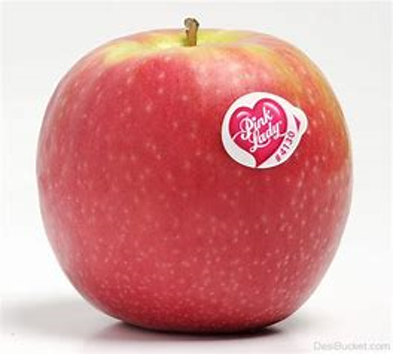 In keeping with the Pink Lady 'module' a branded apple with a high specification and controlled marketing, the future of any variety depends on more than consumer approval. The first hurdle is convincing a Supermarket/s of it's potential and then licensing the variety to a supplier. The brand names Pink Lady (Cripps Pink) Jazz (Scifresh) are well established globally. Of course varieties like Gala and Braeburn are not brand varieties but very 'established' - successful - 'high yielding' volume varieties. In China and the far east, FUJI is King.
In keeping with the Pink Lady 'module' a branded apple with a high specification and controlled marketing, the future of any variety depends on more than consumer approval. The first hurdle is convincing a Supermarket/s of it's potential and then licensing the variety to a supplier. The brand names Pink Lady (Cripps Pink) Jazz (Scifresh) are well established globally. Of course varieties like Gala and Braeburn are not brand varieties but very 'established' - successful - 'high yielding' volume varieties. In China and the far east, FUJI is King.
The apples sought by today's consumers tend to be sweeter than varieties of old. The sugar (brix) levels of all varieties have minimum levels set by Supermarket specifications.
At Interpoma there are always countless varieties on display; some new and some established. Many are improved clones (sports) of established varieties familiar to consumers when visiting their Supermarket. Some are new crosses.
The plethora of varieties available from breeders and nurseries demonstrates a diverse mix of red, green and yellow apples. Many bred from Golden Delicious (with its propensity to produce heavy yields) crossed with varieties with characteristics (especially disease resistance) likely to produce a new tasty apple.
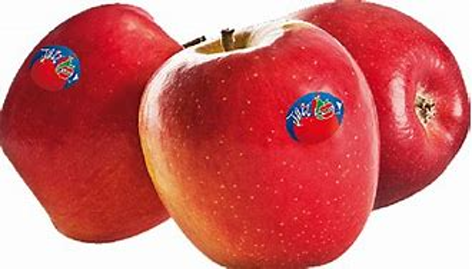 As I circulated the varietal offers on show, the majority will have no appeal to UK growers or consumers. Of course our top fruit industry is small in comparison to the large volume producers across Europe and one assumes 'somewhere' there is a potential place for every new variety. I use the word 'potential' as many of course will 'fall by the wayside' once introduced to a wider audience.
As I circulated the varietal offers on show, the majority will have no appeal to UK growers or consumers. Of course our top fruit industry is small in comparison to the large volume producers across Europe and one assumes 'somewhere' there is a potential place for every new variety. I use the word 'potential' as many of course will 'fall by the wayside' once introduced to a wider audience.
The South Tyrol produces in excess of 1,000,000 tonnes of apples and is a major producer. Varieties include; Idared, Elstar, Fuji, Braeburn, Jonagold, Gala, Kanzi, Rubens, Modi, Golden Delicious, Winesap, Granny Smith, Red Delicious, Morgenduft, Pink Lady, Pinova, Topaz, Jazz.
Although the region produces many varieties of apples, historically no meaningful (commercial) apples have originated in South Tyrol. There was much excitement when a variety bred in South Tyrol was officially launched at The Interpoma Trade Show.
Fengapi
ORIGIN: Fengapi is a cross between Gala x Pink Rose.
It's colour is an intense brilliant red colour, with a yellow-greenish ground background colour, slightly striped on the side not facing the sun. Flavour is reported as sweet, with low acidity and aromatic. Shape/size: medium, long shaped; the skin is smooth with no problems with russeting, sunburn or lenticel irritation. The flesh is crispy, juicy and firm.
TREE: Vigour is reported to be medium, uniform, well-branched. The blossom: early bud burst, mid-early blossom, constant and rich.
Although the English Apple Man has not hade the opportunity to taste Fengapi, by it's description it sounds remarkably like Jazz or Pink Lady. It's appearance at Interpoma looked very much like Jazz.
Click on: FENGAPI
Another red apple seemed prominent at Interpoma: Dark Baron a very dark red Gala clone, ideal for Southern European countries where a day night contrast in temperature is lacking. Gala One is becoming established as an earlier maturing Gala clone developed by Johan Nicolai.
STORY® Inored is a very dark apple, 3/4 to full red; resistant to common strains of scab, but susceptible to powdery mildew. Bug Bucks is a clone of Gala with high red colour. Found in January 2011 on Oak Valley Estate in the Elgin valley in South Africa. Because Bigbucks fruit is already a full red apple approximately two to three weeks before optimum maturity is reached, growers can easily harvest too early. Unlike striped Galas where the background colour can be used as an indication of maturity, Bigbucks's full red blush causes the background colour to be virtually invisible.
Below: left; STORY Infored and right; Big Bucks
Rubelit is a Topaz X UEB 2732/2 Scab resistant and Mildew tolerant, intense red colour on green-yellow background. Topaz with its 'inbuilt scab resistance' is a popular 'parent choice' when crossing with 'precocious varieties' (like Golden Delicious) as breeders seek new varieties with resistant genes.
Below: left; Rubelit and right; EUB 6581, another from the same stable
Below: on the DALIVAL stand - left; an improved sport of Granny Smith and right; Jeromine Red Delicious a superior apple to standard Red Delicious
ZOUK varieties
ZOUK is the new variety development company owned by Johan Nicolai.
Zouk37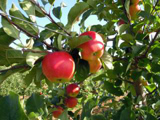 - Parents: Rubinstep COV X Nicoter COV
- Parents: Rubinstep COV X Nicoter COV
- Harvest time: 10 days before Gala
- Very productive and easy coloring
- Good size and heavy fruits
- Indication of tolerance against scab and mildew
Zouk16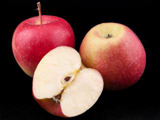 - Parents: Nicoter COV X Nicogreen COV
- Parents: Nicoter COV X Nicogreen COV
- Harvest: Golden Delicious + 10 days
- Very productive and easy coloring
- Bright pink on a light yellow background with white lenticels
- Apple with high density
- Does not oxidize due to high vitamin c content
Zouk31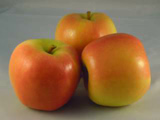 - Parents: Rubinstep COV X Nicoter COV
- Parents: Rubinstep COV X Nicoter COV
- Harvest: Golden Delicious + 5 days
- Distinctive appearance: golden green with an orange blush
- Productive
- Size: 70-75
Zouk32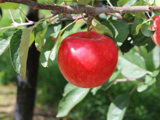 - Parents: Rubinstep COV X Nicoter COV
- Parents: Rubinstep COV X Nicoter COV
- Harvest: 1 week after Gala
- Very productive and easy coloring
- Fuji-appearance
- Size: 70-80
- High tolerance against scab and mildew
Zouk18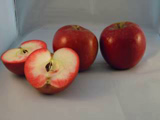 - Harvest: same period as Gala
- Harvest: same period as Gala
- Red flesh apple, one quarter red and three quarters white.
- Productive, medium size.
- Deep red colour.
Mazzoni
Mazzoni created Bibaum trees and their twin leader trees have proved very successful in The South Tyrol and in a number of UK orchards.
Red fleshed apples with higher antioxidants are on most breeders list. Two at Interpoma, Red Love and Red Moon.
Below: left; Red Love and right; Red Moon
The Red Love variety was raised in Switzerland by ace apple breeder Markus Kobelt who spent many years developing it. It's the first of a series of red-fleshed apples, the Redlove® Series.
Starting with parents which were disease-resistant and with sweet firm flesh, he spent many years of careful pollination and selection before choosing this unique variety. After all, think how long it takes an apple to go from a germinating seed to a fruit you can taste. And if you're a plant breeder you may well have to go through this time and again before you get something really good.
Red Moon® is a new umbrella brand for a series of red flesh apples.
They are perfect for 2 aspects:
1. They are of good eating quality, and have a good storage till the spring;
2. They are good for processing, as they do not oxydate: the red flesh colour keeps the red by the time; also the packout is very good.
Below: many beautiful apples were on display at Interpoma, but these ceramics by EVA DESIGN caught The English Apple Man's eye
Click on EVA DESIGN you will be amazed!
Pink Lady is mentioned often by me as an example of the perfect commercial apple, delivering a great eat for apple lovers and a profitable variety for growers because of it's quality and supreme marketing.
Read about the creator John Cripps (with thanks to Wikipedia)
John Ernest Lane Cripps AO (born 9 April 1927) is a British-Australian horticulturalist. He is best known for breeding the Pink Lady ('Cripps Pink') and Sundowner ('Cripps Red') apples.
Cripps was born in Steyning, Sussex, England, and completed a degree in horticulture at the University of Reading. In 1955, he emigrated to Perth, Western Australia following a job offer from the Western Australia Department of Agriculture.
He became a specialist horticulturalist with the department in 1959, and worked on developing rootstocks and strategies to optimise horticultural production in Western Australia.
In 2010, he was inducted into the Hall of Fame of the Royal Agricultural Society of Western Australia for significant influence on the apple industry of Australia. In 2015, he was made an Officer of the Order of Australia (AO) for distinguished service to primary industry through internationally renowned, innovative contributions to the agriculture and food sectors, and to the community.
That is it for this week, until next week..
Take care
The English Apple Man